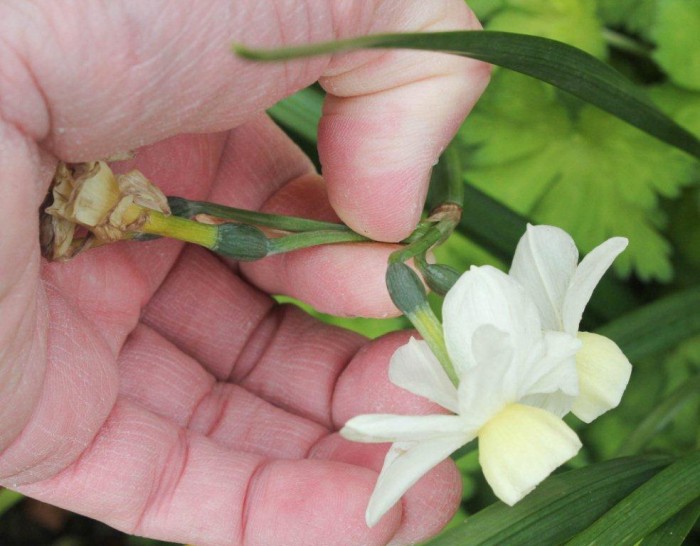
Removing faded flowers or ‘dead heading’, (see image) is a wonderful job for a late spring day, it extends the flowering season of annuals, hanging basket plants like Pelargonium’s, herbaceous plants – even shrubs, where it’s practical and is vital for sweet peas, which stop flowering if they are allowed to produce seed. Cutting bunches of sweet peas has the same effect, as does harvesting ‘podded’ crops like peas and runner beans; harvest regularly or they stop cropping. The only plants which are not deadheaded are those that are grown for their ornamental fruit or if you want to collect the seeds later in the season. Deadheading roses before they die and the petals fall means there’s less tidying up to do; fading flowers should be cut from cluster flowered roses individually, rather than waiting for the last flower in the cluster to fall. Only cut the flower heads from bulbs, leave the leaves and stems to produce energy, so it flowers next year. Taller flowers like Lupins and Delphiums should be cut back before the last flowers fade, removing the stalk to just above the leaves, this often encourages other, smaller spike of flowers to form. Lavenders can be trimmed as the flowers fade and the flowerhead’s saved for lavender bags or for posies indoors.
As greenhouse tomatoes are romping away, remove the side shoots of ‘cordon’ varieties to maintain a single stem. Just break them off with your finger and thumb – there’s no need to use secateurs. Make sure that your tomato plants are well watered, too, particularly if they are in growing bags, which dry out rapidly – twice a day if you can, one large soaking often leads to water-logging. Erratic watering causes calcium deficiency and ‘blossom end rot’, when the end of the fruit furthest away from the stem, turns flat and black, it is unsightly but cut this off and the fruit are still edible. It can be avoided by only planting two tomatoes per bag, using a technique known as ‘ring culture’ – cutting off the base of a 10-12” pot, inserting it into the whole cut in the top of a growing bag, then filling the pot with compost to increase the size of the root system or growing in a greenhouse border.
I dug out a large ‘Guelder Rose’ (Viburnum opulus) in my garden last spring, disillusioned by the damage caused to the leaves by Viburnum Beetle – it leaves the whole plant with more holes than a doily and attacks other Viburnum’s, notably Viburnum tinus, too. Larvae cause most if the damage in spring, (it will be very obvious by now) but adults can attack in late summer. There are too many larvae to pick them off by hand but look for damage in early spring, as the larvae hatch out and spray with pyrethrum immediately – several applications may be necessary as this contact organic chemical does not control the adults.. Happy Gardening!


